Music and Everything
A Brief History of the Cosmic Octave
Text by Fritz Dobetzberger
Music combines two different frequency bands: tempo and tones. Tones are audible frequencies in the range of about 20 to 20 000 Hz and these tones are played at a certain tempo, for example at 60 bpm (beats per minute), which would be once per second (1 Hz).

For the artistic union of the two areas tempi and tones the term music is common. What is still missing is a catchy, generally used term for the art of combining all harmonic vibration ranges: For the connection of astronomical cycles or molecular frequencies with music and colors and other ranges. Hans Cousto recognized the formula for this in 1978.
What happened so far (until 1978)
All or almost all music cultures are based on scales that gradate the spectrum between one and twice the audio frequency. There is a natural reason for this: a tone that has a certain frequency resonates also at double the frequency. This is illustrated by the vibrating string of a musical instrument: not only does it oscillate back and forth along its entire length, but the two halves also oscillate back and forth within themselves, and the three thirds, four quarters, five fifths, and so on. The halving can be seen and heard most clearly. Nature alone produces twice the frequency (or half the wavelength), it proportions itself.
Half Half
In occidental culture the ratio of 1 to 2 is called 'Octave', according to a seven-step scale, the eighth tone is then the octave tone (lat. octō 'eight'). The octave tone is so closely related to the fundamental frequency that it is given the same name. The scale A, B, C, D, E, F, G and A forms the basis of modern music notation.
Different musical cultures differ in the way in which a spectrum is graded from one frequency to double frequency in five-, twelve- or differently graduated scales, in church or blues scales, Greek, Arabic, Indian, Chinese scales and so on and so forth.
Frequency doubling is also decisive in the spectrum of musical tempos. Twice as fast tempos are noted as whole, half, quarter, eighth, sixteenth notes, etc.
The application of the ratio of 1:2 as the basis of music is a paradigm, a way of thinking for the (almost) entire cultural area of music. If the boundaries of this space are crossed and expanded, a new, expanded paradigm emerges.

In those days :)
In the autumn of 1978, the Swiss mathematician and music researcher Hans Cousto realized that the octave - the doubling of fequencies - could serve to artfully combine all possible vibration ranges beyond music.
How and where did Cousto come up with his idea, in which milieu? As a contemporary witness, I take the liberty of telling the following from my point of view. At that time we were a flat-sharing community in Munich, directly at the English Garden near the Monopteros in the old town house Riedlstraße 7: three floors, open doors; toilets in the half-floor; washbasins in the stairwell; common clothes shelves in the anteroom. The society called us hippies.
We travelled, especially to India, and got to know other cultures. We became interested in universal contexts, certainly inspired by Hermann Hesse's Nobel Prize-winning novel "The Glass Bead Game", in which he describes a language of signs and formulas in which mathematics and music have an equal part and which makes it possible to combine astronomical and musical formulas and to bring mathematics, architecture, art and music to a common denominator.
As musicians, painters and mathematicians, we were interested in measurement systems and harmonics. Because basic measurements such as the meter were mostly derived from nature, we wanted to know the origin of the 440 Hz chamber tone, which was established in Europe as the official tuning tone in 1939 (as we now know without a specified reference to a natural constant).

Planetary frequencies
Since October 2nd, 1978 we have been using cosmic tunes. On this day, Cousto found and ate magic mushrooms, Psilocybe semilanceat in the English Garden. Thereupon he heard and saw in a vision how the planets of the solar system give a concert in a light show of rainbow colours. This led him to an eye-opener. Cousto took his pocket calculator and 'octavated' the rotation frequency of the earth. The formula is quite simple:
A rotation of the earth around its own axis takes a day with 24 hours each, 60 minutes each, 60 seconds each, i.e. 86400 seconds. At the calculator: 24 x 60 x 60 = 86400.
The reciprocal of time is frequency:
1 : 86400 = 0.000 011 574 Hz.
This inaudibly low frequency was doubled by Cousto until an audible tone frequency was calculated: 25 doublings, i.e. 25 octaves, result in 388.36 Hz, or one octave lower 194.18 Hz.
Next, he determined the octave frequency of the Earth's solar orbit. The frequency of 1 time per year is 32 octaves higher a tone with 136.10 Hz
I remember Cousto presenting us the octave frequencies of the earth, the moon and the planets as numbers on paper in the small room in the attic and telling us how he came up with them. Inspired by the genius of his idea, we wanted to hear these sound frequencies naturally. Since we didn't have any synthesizers or tone generators at that time, we had tuning forks made.

Rainer Kohlwald, also a member of our residential community, and Cousto ordered 100 tuning forks each with the frequencies of the earth tones and the Venus tone from the manufacturer. Most of the tuning forks were given away to friends, some were also sold. The first customer was the drummer Peter Leopold, who was playing with the group Amon Düll II at the time. In December 1980, Peter Leopold presented a set of tuning forks with earth, moon and planet tones to Robert Paiste. Years later, the renowned gong forge PAISTE began producing the Planet Gongs.

Sadja
As one of the first experiences with the tuning fork we noticed in comparisons with record recordings and later at concerts that Indian master musicians tune their sitar very precisely to the earth-year-tone C# 136.10 Hz. The astonishing thing about it is that they tune this fundamental intuitively, without using tuning forks, without having frequency numbers ready.
That the Indian basic tone, called Sadja, father of all other tones, corresponds to the octave frequency of the earth year, did not surprise us too much, since the calculations are based on the natural octave law. What is astonishing for our occidental culture, however, is how the Indians come to this tone without knowing the numbers.
For me, the following experience was like looking through a keyhole: One day I tuned an Indian sitar with the Earth Year Tuning Fork so precisely that all other strings resonated after striking the lowest sounding string. Late at night we sat in a small circle in the room where the well tuned sitar stood. We were all in a completely relaxed mood - and heard how the sitar strings resonated and accompanied the sound of our sometimes spoken words!
Indian masters do not seem ostensibly to seek a certain tone frequency but to swing by themselves in a meditative serenity in this tone. According to my experience with the sitar resonating to the sound of the words, the mood is a relaxed and cordial one, with - I suppose - a low brainwave frequency, similar to awakening after a deep sleep, even before the onset of the usual hustle and bustle.
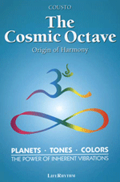
Publications by Hans Cousto
The circle of friends was curious and repeatedly asked questions about the derivation of these tone colours. This prompted Cousto to present his idea in the spring of 1979 in two handwritten brochure, photocopied 250 times and bound with a sewing machine, entitled "Farbton Tonfarbe und die Kosmische Oktave" (part 1 and 2). From these booklets, the bilingual booklet "Farbton Tonfarbe und die Kosmische Oktave - Relating Sound to Colors and the Cosmic Octave" was produced in 1980, of which Cousto had 20,000 copies self-published with professional typesetting.
1n 1984, Synthesis Verlag, Essen, Germany, published the "Astrotafel", a poster designed together with Bernhard Kleefeld in 13-colour printing. In the same year, the publishing house also brought out Cousto's 224-page basic work "Die Kosmische Oktave - Planeten Klänge Farben - Der Weg zum universellen Einklang" (The Cosmic Octave - Planets Sounds Colours - The Path to Universal Harmony).
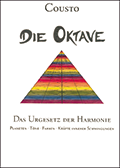
His popular scientific book "Die Oktave - Das Urgesetz der Harmonie - Planeten, Moleküle, Atome, Töne, Farben - Kräfte innerer Schwingungen" (The Octave - The Primal Law of Harmony - Planets, Molecules, Atoms, Tones, Colours - Forces of Inner Vibrations) was published in 1987 by Simon+Leutner, Berlin. The following year, its English edition entitled "The Cosmic Octave" was published by LifeRhythm, USA and in 1990 the Dutch edition "Het Kosmisch Octaff" was published by Panta Rhei.
In 1987, "Die Töne der Kosmischen Oktave" was published by Simon+Leutner Berlin and the 2nd edition in co-production with Planetware. The English-language edition entitled "The Cosmic Octave Tuning Yorks" is available as a PDF. The content is now also available in English, Italian, Fresh und Spanish websites and as PDFs.
In 1991, Cousto conceived with Matthias Pauschel the ORPHEUS mindmachine for stimulating brainwaves with the octave frequencies of the three cycles of the earth day, year and Platonic year. The accompanying "Orpheus Handbuch - Die Wirkung der Rhythmen unserer Erde auf Körper, Seele und Geist" (Orpheus Handbook - The Effect of the Rhythms of Our Earth on Body, Soul and Spirit) was also published by Simon+Leutner Verlag.
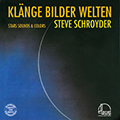
„Klänge Bilder Welten – Musik im Einklang mit der Natur“ (Sounds, images, worlds - music in harmony with nature). was published in 1989. Steve Schroyder put the calculations described in it into music on the album of the same name. The book and the music, as well as Schroyder's album „SUN - Spirit of Cheops“, which is based on proportions of the Cheops pyramid, were also published by Simon+Leutner in 1990 and 1992.
Towards the end of the 1990s, Cousto determined the tones of the hydrogen spectrum and then also the octave tones of psychoactive molecules such as MDMA, THC, CBD, LSD and DMT (he websites are in German).
This and other German publications by Hans Cousto are listed on a Planetware website.
Elliptical tones
Forty years after Cousto's idea, the harmonist Norbert Böhm used the law of the cosmic octave to acoustically represent the varying speed of a planet on its elliptical orbit. In 2019, his work „Sphärenmusik“ was published.

ColorMusic
The violet end of the rainbow has about twice the frequency of the red end. The light spectrum therefore comprises one octave. This makes it possible to see a color as a higher octave of a tone (or any other frequency). So a tone A with 440 Hz is many octaves over the audible range a light frequency that we see as yellow-orange. Twelve-tone scale and twelve-color circle are similar, both divide the octave space into 12 steps.
Accordingly, we first colored the piano keyboard of Michael Samay, pianist and close friend of the house. His brother Martin designed the first rudimentary colour notes, which Johannes Paul and Fritz Dobretzberger perfected over the years to the diagramm-like colour notes. In 1993 our book "Farbmusik - Leitfaden für eine kombinierte Farben- und Musiklehre" (ColorMusic - Guide to Combining Color and Music Teaching) was published by Simon+Leutner Verlag in Berlin.

Practical applications
Shortly after planetary tuning forks became available, naturopaths began to take an interest in them and to use them for sound puncture, for example for relaxation or stimulation or instead of acupuncture with needles. For hedonistic and especially for meditative purposes, the tuning frequencies are also used, especially those of our planet Earth.
Of course, it is obvious to use the tuning fork according to its original purpose: to tune music, which is now to sound in harmony with the nature of our cosmos, instead of in the brurocratically recommended concert pitch of 440 Hz.
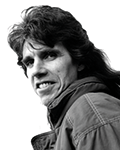
The following is a list of pioneering artists and projects who compose with tones of the Cosmic Octave and have predominantly dealt with it in their art since Cousto's idea.
In 1987, the musician Steve Schroyder (also known as a former member of Tangerine Dream, Star Sounds Orchestra and other bands) and Hans Cousto got to know each other As a pioneer of electronic music interested early on in creating spherical sounds, the idea of the Cosmic Octave naturally suited him. The albums "Klänge Bilder Welten" and "Sun - Spirit of Cheops" mentioned above were created in collaboration with Cousto.
.
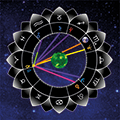
On the basis of planetary frequencies and the commonality of musical intervals and geometric angular relationships recognised by Johannes Kepler at the beginning of the 17th century. Cousto and Schroyder set the first planetary constellations to music on the basis of the planetary frequencies and the commonality of musical intervals and geometric angular relationships recognised by Johannes Kepler at the beginning of the 17th century. In the Starsounds project, Steve and I continue this activity in commissioned works.
In 1989 Steve Schroyder and the gong player Jens Zygar formed the Star Sounds Orchestra. At the inaugural concert in Solothurn, Switzerland, a complete set of PAISTE Planet gongs filled the stage as a world premiere. Significantly, the SSO's debut album is titled "Planets". Further albums and concerts around the globe followed. A chronicle can be found on the Planetware website. The SSO disbanded in 2015.
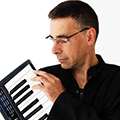
As the Akasha Project, the electronic musician Barnim Schultze also dedicates himself to planetary and molecularly tuned music. Among other things, he has set the frequency spectra of hydrogen, MDMA and LSD to music.
B. Ashra composes electronic music with planetary tones and with frequencies of molecular agents such as DMT, CBD, THC and other tones of the Cosmic Octave.
The group Brain Entertainment Laboratory, with Akasha Project, B. Ashra, Tommelon and Eru, released the albums "The Sound of THC" and "In Ovo - Live at Fusion Festival 2005" tuned to THC tones.
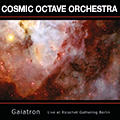
The Cosmic Octave Orchestra, with Steve Schroyder, Akasha Project and B. Ashra, gave a concert at the 'Ricochet Gathering' Festival 2010 in Berlin that is recorded in its entirety on the album "Gaiatron".
Planetary Cymatic Resonance is a music project by Timo Preece and Steffen Günther. They also tune their compositions according to planetary or molecular natural frequencies.

Planetware presents a number of other Cosmic Octave musicianson a German website and on the Planetware Record channel on YouTube
The music label Klangwirkstoff Records, run by Bert Olke and Thomas Wölke, sees itself as a crystallisation point for musical research into the effect of cosmically transposed natural frequencies.

Steve Schroyder and I founded Planetware Records in 2005, also to release music in tunings of the Cosmic Octave. The maxisingle "Lets Mozart" by Star Sounds Orchestra feat. Blue Violin, with electronically arranged compositions by Wolfgang Amadeus Mozart, was our first release on the occasion of his 250th birthday on 27 January 2006. More and more cosmically tuned music is appearing. Much of it is presented, in addition to our own publications, on the Planetware Record channel on YouTube

Already in 1990 I founded the company Planetware, whose central theme is the theory and practice of the Cosmic Octave. The website offers extensive information on frequencies from our planetary and molecular nature, including detailed tuning data. Many scripts are available for free download as PDFs.
Hans Cousto's biography, publications, video-recorded lectures and a chronicle of events can also be found in German on planetware.de.
Besides theory, practical applications, tuning forks, sound instruments, colour notes and much more is presented. Much of it is available for purchase in the Planetware-eShop.
Translated from German with www.DeepL.com/Translator.
